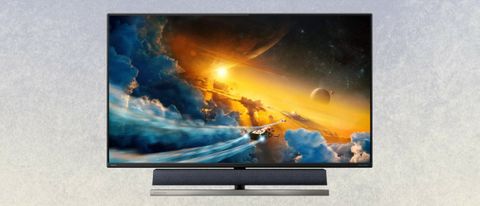Why you can trust Tom's Hardware
To learn about our HDR testing, see our breakdown of how we test PC monitors.
With a 1,000-nit backlight, the 558M1RY’s HDR promise is great. With no full-array local dimming (FALD) backlight here, like what you’ll find on many of the best HDR monitors, you’ll need dynamic contrast to render truly excellent HDR. Luckily, Philips did its homework.
HDR Brightness & Contrast



For these tests, we measured the Personal and DisplayHDR 1000 modes once the HDR signal was applied. Personal tops out at around 750 nits, which is plenty for any living room or office. If you want the monitor’s full brightness capability though, select the DisplayHDR 1000 mode and watch the peak output go over 1,276 nits. That’s seriously bright. You’ll want to use that when there is a lot of ambient light, like sunlit windows or floodlights. For most environments, Personal is fine, and it also provides better color accuracy.
With super-low black levels, the 558M1RY delivers an impressive 30,720.7:1 contrast ratio for HDR content. That’s a depth you can easily see. Properly-encoded HDR content looks fantastic here, and we had to remind ourselves that the backlight is not a FALD unit. Philips has done a great job here. Only the FALD-equipped HP and Alienware OLED can beat it.
Grayscale, EOTF & Color




You can see the difference between Personal and DisplayHDR 1000 modes above. The latter has a reddish-green tint, which is visible in real-life content, at 40% brightness and higher. The EOTF luminance curve follows the spec reasonably well but gets to the tone-map transition point a little soon. Still, DisplayHDR 100 mode is the mode to choose if you want maximum brightness, as its color, especially red, is also over-saturated.
Personal is much more color-accurate with near perfect DCI-P3 target matching and grayscale that’s a little blue in the brightest parts of the image. The EOTF follows a similar track to the DisplayHDR 1000 mode but the lower peak brightness is easier on the eyes when viewed in average room light or in the dark. Personal is the mode we used for our hands-on tests.
Current page: HDR Performance
Prev Page Grayscale, Gamma & Color Next Page Viewing Angles, Uniformity, Response & Lag
Christian Eberle is a Contributing Editor for Tom's Hardware US. He's a veteran reviewer of A/V equipment, specializing in monitors. Christian began his obsession with tech when he built his first PC in 1991, a 286 running DOS 3.0 at a blazing 12MHz. In 2006, he undertook training from the Imaging Science Foundation in video calibration and testing and thus started a passion for precise imaging that persists to this day. He is also a professional musician with a degree from the New England Conservatory as a classical bassoonist which he used to good effect as a performer with the West Point Army Band from 1987 to 2013. He enjoys watching movies and listening to high-end audio in his custom-built home theater and can be seen riding trails near his home on a race-ready ICE VTX recumbent trike. Christian enjoys the endless summer in Florida where he lives with his wife and Chihuahua and plays with orchestras around the state.
-
waltc3 Nice review...looks nice! Too expensive, imo.Reply
However, it is definitely not a "desktop monitor" since 6' + away is not "desktop", unless your desk is 8-10 feet deep (which most aren't)...;)
This next link is a desktop monitor, definitely, for less than 1/3 the cost: $449.
https://www.benq.com/en-us/monitor/entertainment/ew3270u.html
It's available now from Amazon. The monitor will do 4k, HDR and Freesync 1, as well. I own it and really like it--best monitor I've ever owned, by far. Works great with a display port 1.4 GPU like my 5700XT--important, however, do not go cheap on your DP 1.4 cable! Get a VESA-certified 8K cable like this one (3 meters):
https://www.amazon.com/Infinnet-DisplayPort-Cable-Certified-Meters/dp/B07JJXM4FR/ref=sr_1_4?crid=3269IBD0U4VKE&dchild=1&keywords=infinnet+displayport+1.4&qid=1613939084&s=electronics&sprefix=Infinnet%2Celectronics%2C141&sr=1-4
Highly recommended!
Games like BG3 and No Man's Sky (latest versions) look fantastic in HDR with (or without Freesync--it's your choice). Some other games have poorly coded HDR versions and do not look as good on any GPU/HDR monitor/HDR TV combination, I've discovered. Game devs are definitely making slow but sure progress with their HDR coding.
One of my favorite characteristics of the BenQ is the dot pitch, or the pixel pitch, as it is sometimes called. It's .18, which means you can sit at your desk with this monitor 18" away from your eyes and it will occupy ~80% of your visual field, and you cannot detect individual pixels. From an inch away, if you can focus, you cannot see individual pixels.
Talking about the Soundbar. Let's just say that for less than the $1500 this reviewed monitor costs, you can buy the BenQ & a very nice set of 2.1 speakers (or 5.1, or 7.1 if you want) plus a nice receiver/amplifier to power them, and be way ahead in the sound category. Soundbars are not impressive, imo--better than typical TV speakers, but that's not saying very much...;)
Almost forgot to mention that I run my games @ 60Hz with vsync off and sometimes get far in excess of 120 fps, depending on the game. At lower resolutions I can get literally hundreds of frames per second, and page-tearing is so rare with this monitor that my default game and desktop driver setting is vsync off. -
AnimeMania I am intrigued by the soundbar.Reply
Does the soundbar only function when the monitor is on or does it have it's own power source.
Is there any way for other devices to have access to the soundbar through ports or Bluetooth?
